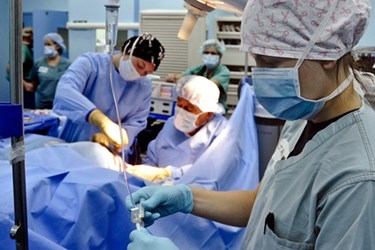Harvard Researchers Create Self-Regenerating Coating For Implantable Devices
By Jof Enriquez,
Follow me on Twitter @jofenriq

Biomedical scientists from Harvard have devised a novel method to regenerate bioactive molecules in surface coatings of implantable medical devices, offering the potential to extend the coatings’ efficacy for longer periods of time.
Implants such as stents, heart valves, vascular grafts, and access catheters usually have antimicrobial and antithrombogenic coatings to prevent infections, biofilms, clots, and the biodegradation of implant material. However, the protective layer has a finite reservoir of bioactive agents, which will exhaust itself over time as it comes into direct contact with blood and other body fluids. This could lead to device failure and the need to replace the implant.
Efforts to enhance the stability and activity of implant coatings have shown promise, but coatings that retain biological activity over extended clinically relevant periods have not been developed.
Now, Harvard researchers says they have devised a chemical reaction mediated by a mutated, lab-developed enzyme called Staphylococcus aureus Sortase A (eSrtA), which not only catalyzes the linking of peptides, but has the ability to break them apart repeatedly. With the new method, implant device coatings could potentially regenerate their bioactive molecules continually.
"We found that through a two-step process of removing and replacing bioactive coatings, eSrtA enables rapid, repeated thin-film regeneration in the presence of whole blood in vitro and in vivo," said David Liu, PhD, professor of chemistry and chemical biology at Harvard University, and a Howard Hughes Medical Institute Investigator, in a press release. "We also developed a series of new enzymes that recognize a variety of distinct peptide sequences that could be put to work in a similar manner."
The Harvard study "establish a rapid, orthogonal and reversible scheme, which can be used to regenerate selective molecular constituents with the potential to extend the lifetime of bioactive films, or likewise, as a method to load and release any of a number of material bound constituents for controlled drug loading and delivery, or as a strategy for material dissolution," the researchers wrote in the study abstract, as published in the journal Nature.
Bacterial enzymes similar to eSrtA, such as streptokinase, uricase, and asparaginase have been used clinically for years, but further studies will need to confirm if eSrtA itself will provoke an immune or inflammatory response, an important consideration for device implants. Researchers also need to determine how the new bioactive coating needs to be regenerated, how long it would last, and when the components eventually would be rendered inaccessible by biologic processes, according to the release.
"Many thousands of people depend on implantable devices with bioactive constituents for their health and well-being, so finding a strategy that will ensure the long-term efficacy of these devices is of paramount importance," said lead author Elliot Chaikof, MD, PhD, Chair of Surgery at Beth Israel Deaconess Medical Center (BIDMC), Professor of Surgery at Harvard Medical School, and an associate faculty member of Harvard's Wyss Institute of Biologically Inspired Engineering, in the release.
"While this research is relatively early stage, it opens the door to a new way of approaching and addressing this clinical challenge," Dr. Chaikof added.
Other biomedical engineers are experimenting with several legacy and newer materials for medical device coatings with antimicrobial and antithrombogenic properties, including liquid-infused polymers, gold nanoparticles, and bioresorbables.
